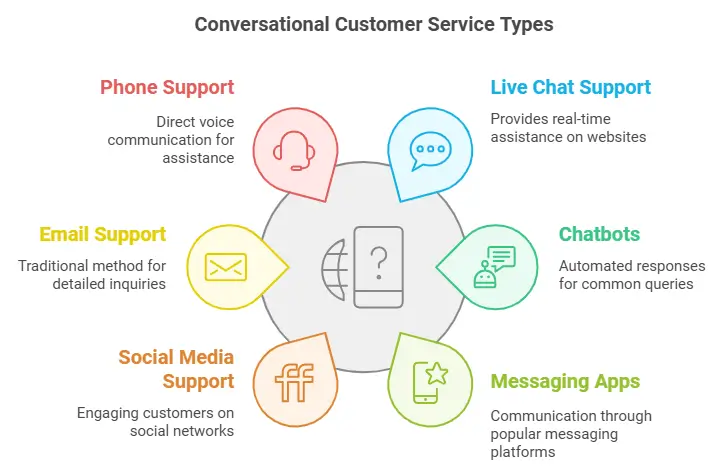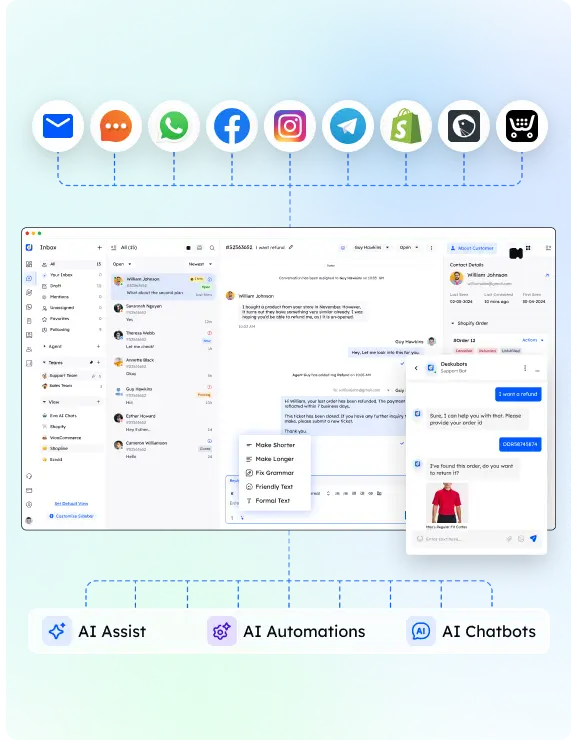In e-commerce, customer service is no longer just about resolving issues. It’s about building meaningful relationships. Conversational customer service focuses on engaging customers across various support channels in a way that feels natural and personalized. Whether it’s through live chat help, Chat applications, or even social media platforms, businesses now have more ways than ever to provide excellent customer service.
The shift toward conversational customer service methods isn’t just a trend. Customers now demand On-the-spot service, immediate access to help, and the ability to interact across various communication channels. Meeting these customer needs can improve customer satisfaction, boost brand loyalty, and even reduce customer churn.
This guide will dive into six essential Interactive support methods that can transform your customer service team and enhance the customer experience. You’ll learn the benefits of each type, how they work, and best practices to implement them for your e-commerce business.
6 Conversational Customer Service Types

1. Live Chat Support
Live chat support is one of the most effective dialogue-based assistance types for e-commerce businesses. It allows customer service agents to interact with customers directly on the website, providing immediate assistance and resolving common customer queries in real time.
Benefits of Live Chat Support
- Instant Responses: Customers get answers to their customer inquiries without waiting on hold for phone calls or email replies.
- Customer Satisfaction: Quick and effective resolutions increase increased customer satisfaction, encouraging customers retention.
- Customer Data Insights: Live chat tools often collect useful user insights like browsing behavior and Purchase logs, helping agents offer personalized support.
- Cost Efficiency: A single support agent can manage multiple chats at once, improving Service productivity and lowering operational costs.
Challenges of Live Chat
- Human support staff vs. Automation: Businesses must strike a balance between Live representatives for complex queries and automation to assist customers efficiently.
- Resource Management: Maintaining a team of trained customer service representatives to handle live chats 24/7 can be resource-intensive.
Best Practices
- Use Chatbots for Initial Queries: Automate responses for common customer queries to free up your client service team for more complex issues.
- Train Your Team: Ensure customer service reps are skilled in managing multiple conversations and maintaining a professional tone.
- Track Metrics: Measure response times, customer feedback, and resolution rates using key performance indicators.
- Offer Multilingual Support: Cater to diverse customer preferences by supporting multiple languages.
Online customer chat creates a seamless customer interaction experience, helping businesses retain happy customers while efficiently managing resources.
2. Chatbots
Chatbots are a cornerstone of modern conversational customer service . Powered by technical support like natural language processing, chatbots can handle a wide range of customer queries and provide immediate assistance without requiring a human support agent. They are ideal for scaling customer support channels in a cost-effective way.
Benefits of Chatbots
- 24/7 Availability: Chatbots ensure customers always have access to help, regardless of time zones or holidays.
- Efficiency in Handling Repetitive Tasks: Automating routine interactions like order tracking and FAQs reduces the burden on customer support representatives.
- Consistent Support: Unlike humans, chatbots don’t tire, ensuring consistent responses to customer questions
- Data Collection: Chatbots can collect valuable insights about customer preferences and behavior during every customer conversation.
Challenges of Chatbots
- Limited Problem-Solving Ability: While they can handle routine queries, chatbots may struggle with complex issues, frustrating unhappy customers.
- Customer Frustration: Customers may prefer talking to a human agent for sensitive or detailed concerns.
Best Practices
- Combine Chatbots with Human Support: Use bots to assist with routine tasks and seamlessly escalate to customer service agents for more complex issues.
- Personalize Interactions: Program chatbots to reference Client information, such as previous interactions and Transaction records, for a more Customized assistance.
- Test and Improve: Regularly update the chatbot’s responses using feedback from customer interactions to ensure relevance.
- Keep It Transparent: Let customers know they’re interacting with a chatbot and offer the option to connect with a support team.
Chatbots are perfect for providing conversational customer support at scale. While they can’t replace human customer support, they’re a great tool to assist users efficiently and reduce operational costs.
3. Messaging Apps
Messaging apps like WhatsApp, Facebook Messenger, and Telegram have become popular support channels for e-commerce businesses. These apps provide a convenient and familiar platform for customer conversations, making it easier to support customers in real time.
Benefits of Messaging Apps
- Direct Access: Customers can reach businesses without navigating websites or making phone calls, aligning with modern customer preferences.
- Real-Time Communication: Instant messaging platforms allow businesses to respond quickly, enhancing customer engagement and promoting customer satisfaction.
- Personalized Support: Integration with consumer details enables personalized service, such as tailored product recommendations.
- Versatile Communication: Businesses can use multimedia like images, videos, and links to clarify responses and guide customers better.
Challenges of Messaging tools
- Resource Management: Managing multiple social media channels and messaging platforms can be overwhelming for the client care team
- Maintaining Speed: Customers expect fast replies, and delayed responses can harm customer relationships.
- Data Security: Ensuring secure communication while handling sensitive buyer records is crucial.
Best Practices
- Centralize Support: Use tools that consolidate messages from various communication channels into a single interface for your service representatives
- Set Expectations: Let customers know response times to manage buyer standards.
- Integrate Chatbots: Automate initial responses on Texting apps to handle common customer questions and escalate more complex issues to a support agent.
- Leverage Features: Use app features like read receipts to ensure efficient customer interactions.
Communication apps bring convenience and personalization to conversational customer service, making them a must-have for businesses looking to enhance the customer journey.
4. Social Media Support
Social media platforms like Facebook, Twitter, and Instagram are now vital conversational customer support channels. These platforms are where customers often voice their opinions, ask questions, and seek help. Providing social media support is key to maintaining a positive customer experience and building strong customer relationships.
Benefits of Social Media Support
- Public Visibility: A quick and helpful response to users inquiries can showcase your commitment to good customer service, boosting your reputation.
- Wide Reach: Engage with a large audience and address multiple queries simultaneously.
- Real-Time Interaction: Respond quickly to direct messages or comments, meeting user requirement for Live customer help.
- Customer Insights: Analyze public posts and interactions to understand customer preferences and improve your service.
Challenges of Social Media Support
- Managing Volume: Handling a high number of customer service interactions across multiple platforms can strain the support team.
- Negative Public Feedback: Complaints or unresolved issues can be visible to other customers, potentially harming the brand.
- Tone Sensitivity: Miscommunication can escalate quickly due to the informal nature of social media.
Best Practices
- Monitor Constantly: Use social listening tools to track mentions, comments, and customer conversations in real time.
- Respond Promptly: Timely replies show customers that you care, increasing customer engagement and reducing the chance of unhappy customers.
- Escalate When Needed: For complex issues, transition to private messaging or direct customers to appropriate self-service portals.
- Stay Professional: Maintain a professional yet approachable tone in responses to align with your brand voice.
Social media is a powerful tool for supporting customers and boosting brand loyalty. With the right strategies, it can enhance the overall conversational customer experience while improving client retention.
5. Email Support
Despite the rise of newer Messaging avenues, email support remains a cornerstone of conversational customer service. It’s especially useful for handling detailed inquiries, complex problems, or situations requiring documentation.
Benefits of Email Support
- Asynchronous Communication: Customers can send inquiries anytime without needing an immediate internet connection, and the support team can reply at their earliest availability.
- Detailed Responses: Emails allow for comprehensive answers to more complex customer queries.
- Professional Tone: Ideal for formal communication, particularly when addressing Frustrated consumers or sensitive issues.
- Traceable Records: Both customers and businesses can keep a clear record of customer service interactions for future reference.
Challenges of Email Support
- Slower Response Times: Customers often expect faster replies, and emails may not meet those expectations compared to Live messaging aid or Texting apps.
- Email Overload: Managing large volumes of email can overwhelm the customer support team, affecting response quality.
- Limited Real-Time Engagement: Email lacks the immediacy of other support channels like social media or live chat.
Best Practices
- Set Response Time Expectations: Inform customers of typical reply times to manage consumer anticipations effectively.
- Use Templates and Personalization: Standardize responses for common consumer queries while personalizing key details like names and purchase history.
- Prioritize and Categorize: Implement tools to sort inquiries by urgency, ensuring critical issues are addressed first.
- Follow Up Promptly: Don’t leave issues unresolved. Confirm satisfaction or escalate to a customer service representative if necessary.
Email support is a reliable way to provide personalized service while maintaining a professional and structured customer journey. It’s particularly valuable for retaining Client interactions in scenarios where detailed communication is essential.
6. Phone Support
Phone support is one of the oldest yet most trusted conversational customer service channels. Hearing a real person’s voice adds a personal touch that’s often unmatched by digital channels. It’s especially effective for handling complex or sensitive customer interactions where direct, immediate communication is essential.
Benefits of Phone Support
- Personalized Service: Speaking with a live customer service agent helps customers feel valued and understood.
- Immediate Assistance: Phone support offers direct, Immediate assistance for urgent customer inquiries.
- Better Conflict Resolution: Complex problems or emotionally charged issues are easier to resolve through a direct conversation.
- Builds Trust: Customers are more likely to trust a business that provides accessible human support.
Challenges of Phone Support
- High Operational Costs: Maintaining a team of trained support agents and managing call systems can be expensive.
- Scalability Issues: Unlike automated DIY support tools, phone support is limited by the availability of Human support staff.
- Customer Frustration: Long hold times or transfers between customer support representatives can lead to dissatisfaction.
Best Practices
- Train Agents Thoroughly: Equip your help desk associates with the skills to handle a variety of situations professionally.
- Use Call Routing Systems: Implement systems that direct customer calls to the right department or agent, reducing hold times.
- Minimize Wait Times: Keep customers updated on their wait time and offer callbacks to maintain Client happiness.
- Follow Up After Calls: Send a summary of the conversation or a feedback request to ensure the issue was resolved effectively.
Phone support remains a vital part of conversational customer service, particularly for customers who value direct, human interaction. It’s a powerful tool for fostering trust and ensuring Customer hold, especially in complex scenarios.
Benefits and Challenges of Conversational Consumer Service Types
Benefits of Conversational Customer Service
- Enhanced Customer Satisfaction: Conversational approaches like Online chat help and messaging application meet modern Client demands by offering real-time customer service.
- Personalized Customer Interactions: Leveraging customer data and tools for personalization strengthens customer building relationships and encourages Brand devotion.
- Increased Efficiency: Automation, such as chatbots, helps assisting customers efficiently and frees up Support staff for complex queries.
- Multichannel Engagement: Offering support through multiple Connection channels like social media platforms, email, and phone calls caters to diverse customers preferences.
- Data-Driven Insights: Analyzing customer service interactions provides actionable insights into customer behavior, improving overall service strategies.
Challenges of Conversational Customer Service
- Resource Management: Maintaining an active presence across multiple support channels can strain the customer team.
- Balancing Automation and Human Support: Over-reliance on automation can frustrate Displeased patrons, while underutilizing it may increase costs.
- Consistency Across Channels: Ensuring seamless, high-quality support across all platforms can be challenging.
- Data Security Concerns: Handling sensitive customer data across various tools and platforms requires robust cybersecurity measures.
- High Customer Expectations: Meeting demands for immediate access and personalized interactions requires well-trained support agents and efficient systems.
This balance of benefits and challenges highlights the importance of choosing the right mix of chat-focused service models for your business needs.
Implementation Tips and Measuring Success
Implementation Tips for Conversational Customer Service
- Select the Right Tools: Invest in platforms that support Multiple contact points such as live chat, chatbots, messaging apps, and social media integration. Tools with natural language processing capabilities can enhance conversational support.
- Train Your Team: Ensure your customer service representatives are skilled in managing both human and automated interactions. Provide training in conflict resolution and data interpretation.
- Automate Repetitive Tasks: Use chatbots and self-service resources for tasks like answering FAQs or updating order statuses. This allows your support agents to focus on complex issues.
- Integrate Systems: Connect customer service platforms with CRM tools to access purchase history, track past interactions, and provide tailored help.
- Set Clear Guidelines: Establish protocols for escalating issues to Live assistants, responding to customer queries, and maintaining consistent responses across all support channels.
Measuring Success in Conversational Customer Service
- Customer Satisfaction (CSAT): Measure how happy customers are with their interactions. Follow up with surveys after resolving issues.
- First Response Time (FRT): Track how quickly your service representatives respond to inquiries across channels like live chat, social media, and email.
- Resolution Rate: Monitor the percentage of issues resolved during the first interaction to evaluate customer service efficiency.
- Customer Retention Rate: Assess how conversational strategies impact your ability to retaining customers.
- Net Promoter Score (NPS): Gauge customer loyalty by asking how likely they are to recommend your business to others.
- Channel Performance Metrics: Analyze the performance of each support channel, including response times and engagement rates, to identify areas for improvement.
Implementing conversational customer service effectively requires careful planning and constant monitoring. Regular evaluation ensures that your strategies align with evolving customer expectation and business goals.
FAQs
1. What are the best real-time support formats for small e-commerce businesses?
Online chat support and messaging apps are ideal for small businesses. They are cost-effective, scalable, and help respond to customers quickly without requiring a large customer support Helpdesk team.
2. How can automation improve customer service efficiency?
Automation, such as chatbots, handles repetitive tasks like answering FAQs or tracking orders. This frees up customer service reps to focus on more complex customer interactions.
3. Can self-service resources replace human agents?
No, but they complement human agents well. Self-service portals handle routine customer queries, while human agents manage complex or emotional concerns.
4. How do I measure the success of my conversational service?
Track metrics like CSAT (Customer Satisfaction), response time, and resolution rate. These KPIs ensure your strategy aligns with customer expectations and business goals.
5. How can conversational strategies reduce customer churn?
Offer Customized assistance and resolve issues promptly. Engage customers through their preferred Contact points to build trust and loyalty.
Conclusion: Elevate Your E-commerce Customer Experience
Providing exceptional good customer service is no longer optional in the e-commerce world—it’s a necessity. Customer support expect seamless, personalized, and real-time customer service across multiple support channels, from live chat support to Social networks. By adopting and optimizing the six conversational care styles, businesses can improve customer satisfaction, reduce customer churn, and build lasting Client connections.
Whether you’re a small business owner or managing a large e-commerce operation, success lies in balancing automation with human interaction. Tools like chatbots and self-service resources enhance efficiency, while traditional customer service agents ensure complex issues are resolved effectively. Tracking key metrics like response times and satisfaction rates ensures your strategy continues to meet evolving customer expectations.
By embracing these strategies, your business can engage customers more effectively, provide Custom service, and drive customer retention—all while standing out in the competitive e-commerce landscape.


